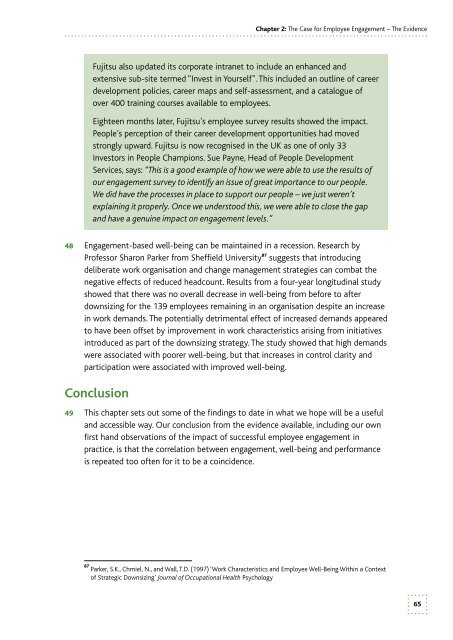3ytgeaf
3ytgeaf
3ytgeaf
You also want an ePaper? Increase the reach of your titles
YUMPU automatically turns print PDFs into web optimized ePapers that Google loves.
Chapter 2: The Case for Employee Engagement – The Evidence<br />
Fujitsu also updated its corporate intranet to include an enhanced and<br />
extensive sub-site termed “Invest in Yourself”. This included an outline of career<br />
development policies, career maps and self-assessment, and a catalogue of<br />
over 400 training courses available to employees.<br />
Eighteen months later, Fujitsu’s employee survey results showed the impact.<br />
People’s perception of their career development opportunities had moved<br />
strongly upward. Fujitsu is now recognised in the UK as one of only 33<br />
Investors in People Champions. Sue Payne, Head of People Development<br />
Services, says: “This is a good example of how we were able to use the results of<br />
our engagement survey to identify an issue of great importance to our people.<br />
We did have the processes in place to support our people – we just weren’t<br />
explaining it properly. Once we understood this, we were able to close the gap<br />
and have a genuine impact on engagement levels.”<br />
48 Engagement-based well-being can be maintained in a recession. Research by<br />
Professor Sharon Parker from Sheffield University 87 suggests that introducing<br />
deliberate work organisation and change management strategies can combat the<br />
negative effects of reduced headcount. Results from a four-year longitudinal study<br />
showed that there was no overall decrease in well-being from before to after<br />
downsizing for the 139 employees remaining in an organisation despite an increase<br />
in work demands. The potentially detrimental effect of increased demands appeared<br />
to have been offset by improvement in work characteristics arising from initiatives<br />
introduced as part of the downsizing strategy. The study showed that high demands<br />
were associated with poorer well-being, but that increases in control clarity and<br />
participation were associated with improved well-being.<br />
Conclusion<br />
49 This chapter sets out some of the findings to date in what we hope will be a useful<br />
and accessible way. Our conclusion from the evidence available, including our own<br />
first hand observations of the impact of successful employee engagement in<br />
practice, is that the correlation between engagement, well-being and performance<br />
is repeated too often for it to be a coincidence.<br />
87<br />
Parker, S.K., Chmiel, N., and Wall, T.D. (1997) ‘Work Characteristics and Employee Well-Being Within a Context<br />
of Strategic Downsizing’ Journal of Occupational Health Psychology<br />
65


